- Wondering how to get Monopoly GO! free rolls? Well, you’ve come to the right place. In this guide, we provide you with a bunch of tips and tricks to get some free rolls for the hit new mobile game. We’ll …
Best Roblox Horror Games to Play Right Now – Updated Weekly
By Adele Wilson
Our Best Roblox Horror Games guide features the scariest and most creative experiences to play right now on the platform!The BEST Roblox Games of The Week – Games You Need To Play!
By Sho Roberts
Our feature shares our pick for the Best Roblox Games of the week! With our feature, we guarantee you'll find something new to play!All Grades in Type Soul – Each Race Explained
By Adele Wilson
Our All Grades in Type Soul guide lists every grade in the game for all races, including how to increase your grade quickly!
Bigfoot Hunter Review: Just Shoot Me
When we first heard about The Tap Lab’s upcoming iOS adventure in photography, Bigfoot Hunter, we immediately began picturing another Pokémon Snap-alike. The camera-toting N64 game has had an unexpected resurgence in recent months, with the charming Snapimals and under-the-radar …
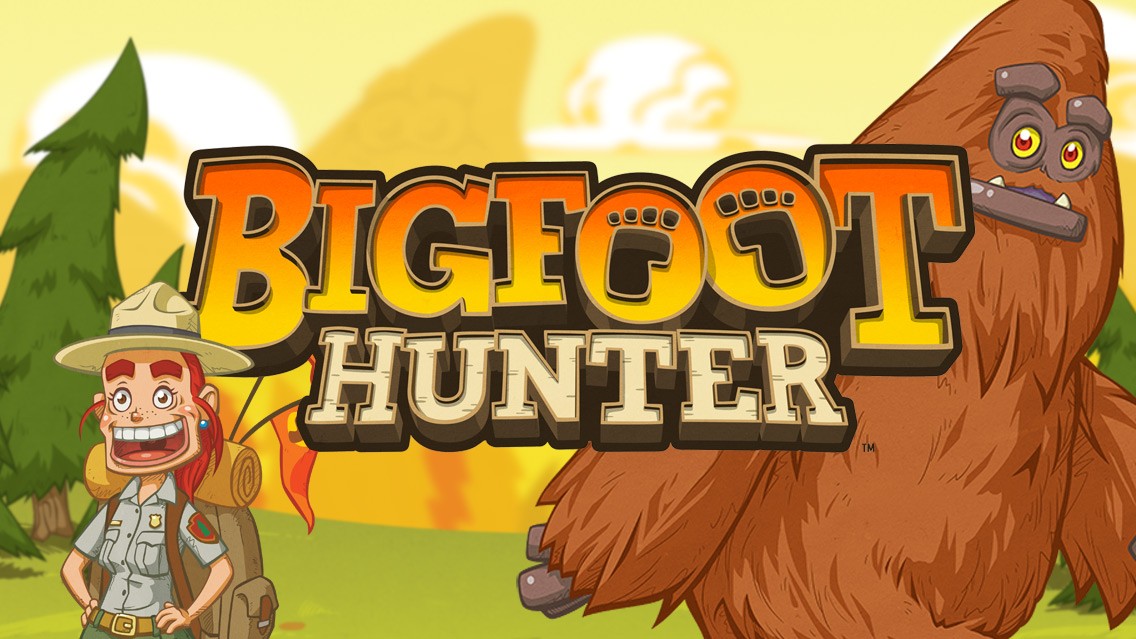
When we first heard about The Tap Lab’s upcoming iOS adventure in photography, Bigfoot Hunter, we immediately began picturing another Pokémon Snap-alike. The camera-toting N64 game has had an unexpected resurgence in recent months, with the charming Snapimals and under-the-radar Finding Monsters Adventure appearing out of seemingly nowhere. The idea of capturing photos of wild animals while on the search for the elusive Bigfoot gave us a similar Snap vibe.
However, shortly into our actual playthrough of Bigfoot Hunter, we realized we had misjudged the gameplay. The only similarity to Pokémon Snap is the use of a camera; otherwise, Bigfoot Hunter is really an arcade shooting game most comparable to Deer Hunter. Players looking for a game that emphasizes stylistic pictures and photo-taking techniques should look to the titles mentioned above. But players interested in a non-lethal variation on the hunting genre may find a suitable, if flawed, match in Bigfoot Hunter.
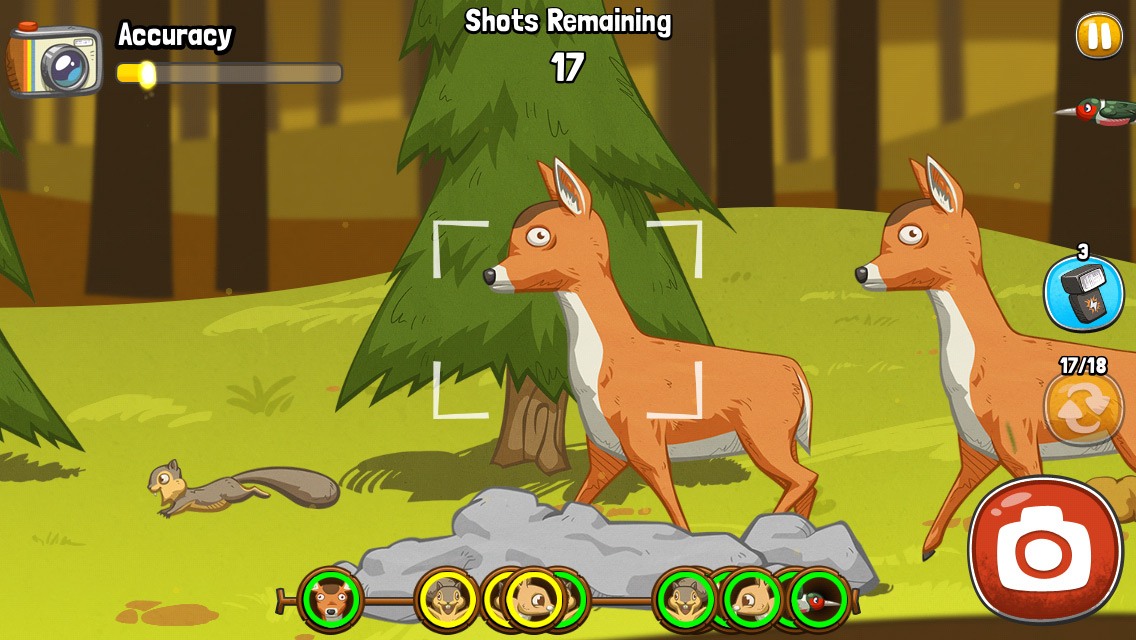
Although your overarching goal in Bigfoot Hunter is to find evidence of the eponymous legend and document it for a museum exhibit, the majority of the gameplay revolves around snapping photos of more common creatures while you wait out the secretive Sasquatch. This takes place within level-based hunts on stationary landscapes: woodland creatures like squirrels and deer will cross the scene and you’ll need to aim and shoot quickly to snag a photo before they vanish off-screen. It feels very much like a shooting gallery, with animals typically sticking to specific lanes within the accessible area. Smaller, ground-bound creatures like rabbits and penguins slide past on the lowest level; larger animals like deer and antelopes bounce by near the middle; and birds and other airborne conquests fly past at the top of the screen.
To capture their photos, you’ll need to move your camera’s reticle around the screen and tap the shutter button when an animal is within the sights—essentially the equivalents of a gun’s crosshairs and trigger. Bigfoot Hunter uses the gyroscope to track up and down movement, and you can also use this method to move left and right. Alternatively, you can use a finger to slide side-to-side, but we found this to be more difficult and less accurate than the gyroscope controls. Using motion controls for all movement in-game feels very natural and like you’re actually using your phone as a camera. They’re also responsive and precise enough that you can quickly dart from one end of the screen to the other without losing your place or becoming disoriented.
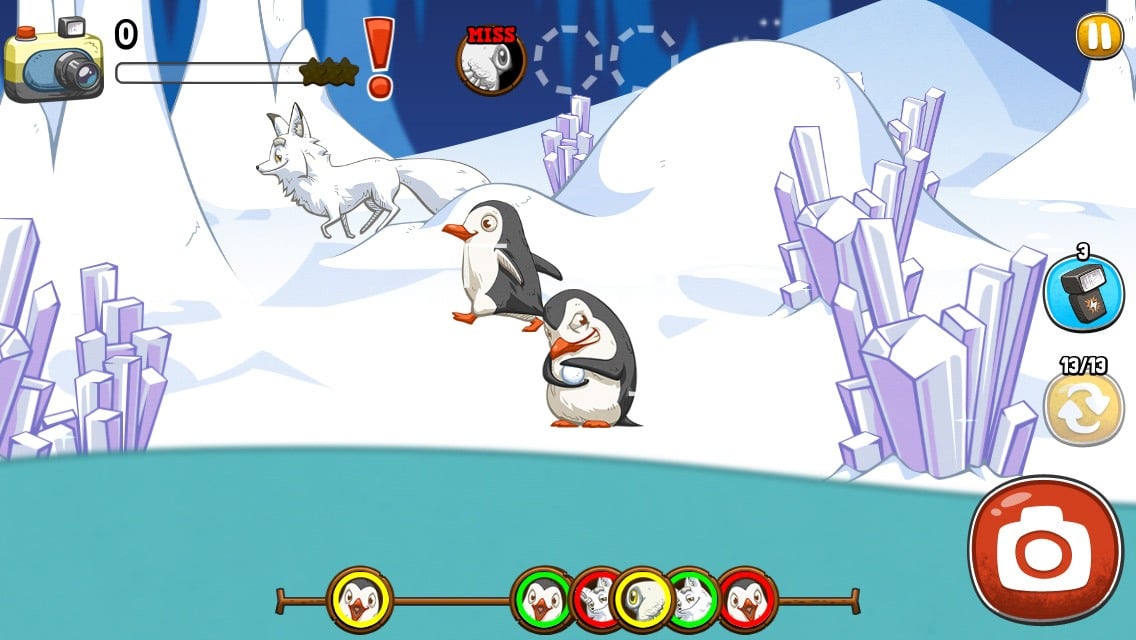
This precision is critical to success, since animals move faster as the levels progress and obstacles become more hazardous if not avoided. Early stage squirrels will throw acorns at you and briefly knock your aim off, but soon you’ll have to contend with freezing snowballs from penguins and screen-blocking pounces from jaguars. Since this is a shooting game at heart, the most important aspect to a high score is accuracy: every animal photographed in a row adds to your score multiplier, and missing even a single shot will reset it and doom you to a less-than-three-stars result. You can earn bonuses for capturing multiple animals in one shot, but there are no points for style or technique; whether you catch an animal in the center of the reticle or on the very edge, it will count.
The main levels all follow the same pattern: a set number of animals will appear over time and cross the screen, showing up on the always-available radar to indicate their position. You’ll photograph them until you’ve caught them all or they’ve escaped (you can miss two animals without failing a stage). Once that set is complete, you’ll move to the next area of the stage. There are usually three-four areas in total, although the stages are identical—only the animal types and their rate of appearance will change. Some levels will end with Bigfoot appearing in the final area; if you capture him on camera as he darts about the screen, you’ll earn a significant bonus for that stage. There are also challenge stages available which require specific goals to be met—like photographing a certain number of animals with a limited amount of film—but these are optional and don’t contribute to the map progress. It’s unfortunate that the primary stages don’t utilize these unique challenges, since they add a variety to the game that is sorely lacking in its numerous main levels.
https://www.youtube.com/watch?v=0awkFxZunqc
When you’re not snapping photos, there are a few other distractions available. You can collect coins from your Bigfoot exhibit, although this is little more than tapping on an icon when it appears, like a bare-bones Disco Zoo. There’s a photo booth that lets you decorate real pictures with stickers of the game’s characters, which is actually one of the more engaging features included. Or you can review your best photos from past hunting excursions or upgrade your camera.
While Bigfoot Hunter is charmingly cartoonish with colorful graphics and quirky animals—the bulging-eyed deer are a personal favorite—and its motion controls are exceptionally implemented and fun to use, the game as a whole suffers from the same issues we found in Deer Hunter 2016. The biggest problems are a lack of variety and an egregiously misbalanced economy that demands grueling grinding of past levels. The former we already touched on briefly: every level has the same gameplay and requirements, outside of the completely optional and unnecessary challenge stages. Animals will always appear in the same order and speed on individual levels, meaning if you played stage 5 ten times in a row, the same squirrel will show up at the ten-second mark at the same spot every single time. And unlike actual hunting games that offer different types of guns, Bigfoot Hunter’s cameras all operate identically. One may hold more film or reload slightly faster, but the experience of using them is always the same.
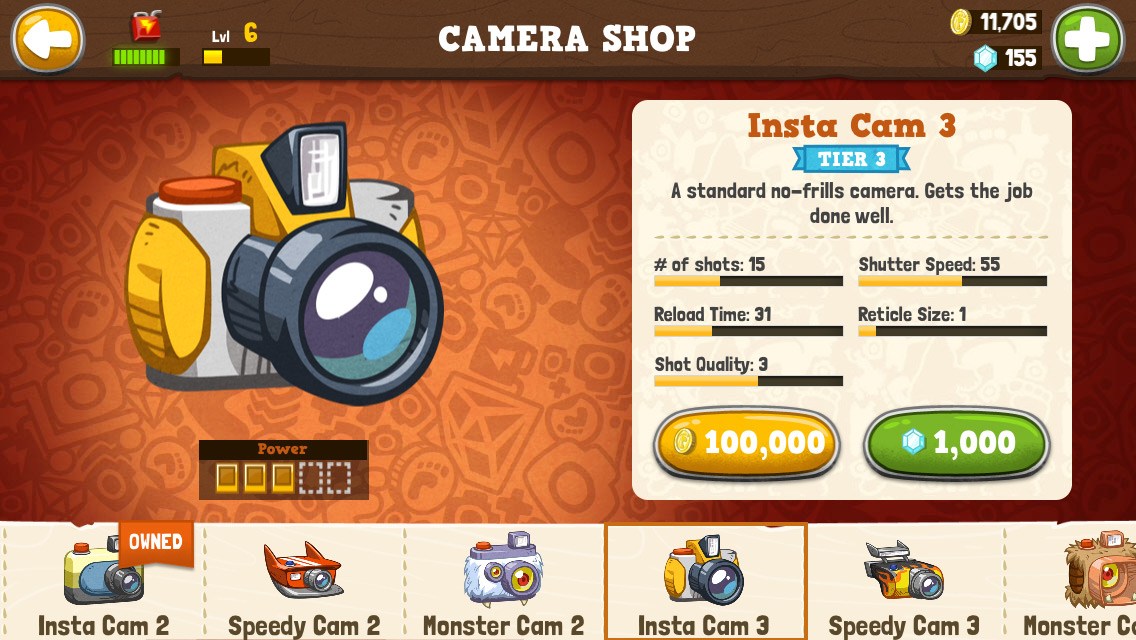
As for the economy, it’s so poorly balanced that it almost seems like a miscalculation. It’s hard to believe anyone would actually think the coin and gem requirements that currently exist would make for a fair gaming experience. First, let’s cover what the economy entails: there is a common currency, coins. These are earned by completing levels—the better you do, the more coins you earn—watching a video at the end of levels—which doubles the amount of coins you earned on that stage—and by tapping on your Bigfoot exhibit—which gives so few coins that it’s hardly worth the miniscule energy exertion. There is also a premium currency, gems. These are really only earned by leveling up, and in very small numbers—about 15 gems per level. There’s also an energy system used to actually play levels. Main, map-progressing stages cost two energy to play (or replay) and challenge stages cost one. You have a max of ten energy at a time, but energy is refilled upon leveling up and can also be filled by watching a video. The energy system is really not an issue and will hardly ever block your progress. The currency, however, is another story.
First, forget using gems for anything. Any gem requirements will be way out of your price range no matter how many you attempt to save. Unfortunately, the power-ups in the game that help you get past tough stages all require gems to purchase. Want to use a bomb on a jaguar-filled stage to photograph everything on screen? You can buy three (single-use) bombs for 144 gems. For comparison, I haven’t spent a single gem in five days of playtime, and I’ve only saved 155 gems. The worst camera starts at 100 gems and their prices increase exponentially (up to 6,230 for the best camera).
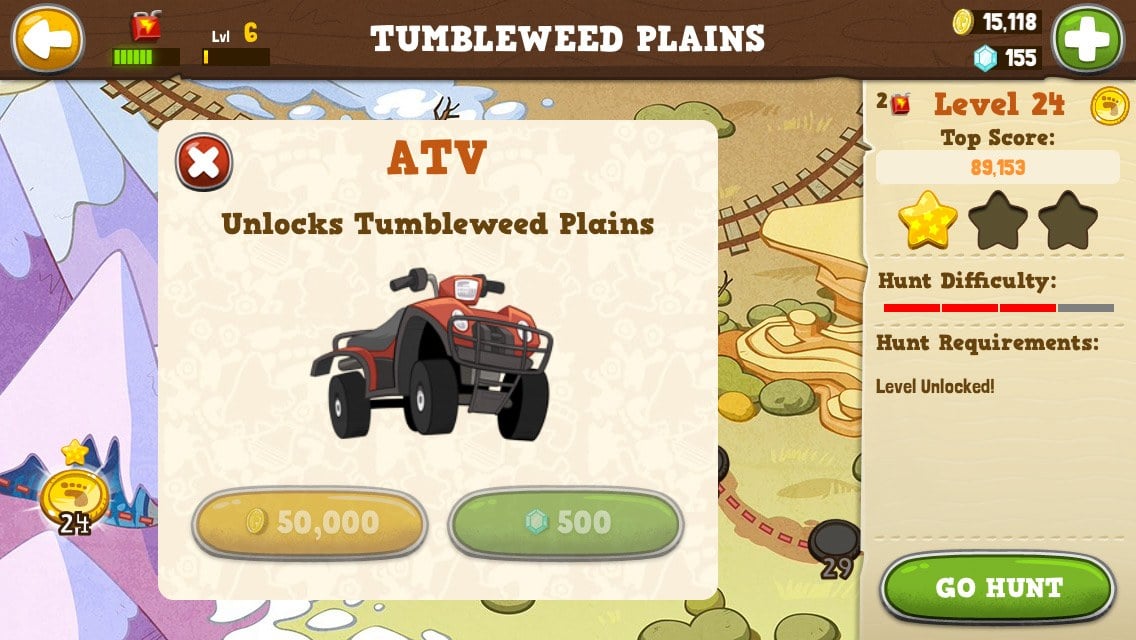
Luckily, you can use coins to buy cameras. But the coin cost is just as absurd, and it’s made even more frustrating by the fact that you have to buy new cameras to progress through the stages. This is in addition to the entry cost for new worlds. Here’s another fun example: to enter the third world, “Tumbleweed Plains,” we had to pay 50,000 coins for an ATV. (This is really just an entry ticket—it’s not like you get to ride around on an ATV in-game.) Then, after playing one level in the new area, the next stage required we have a tier-three camera. A tier-three camera costs 100,000 coins (or 1,000 gems). So, just to access level 3-2, we had to spend 150,000 coins. On average, we were earning about 2,000 coins per level at this point, or 4,000 if we watched a video at the end of every stage. So that meant grinding the same stages almost forty times, and watching a video ad each time, just to move forward.
On top of this mind-numbing grind, upgrading your camera isn’t even actually helpful. The new camera is almost certainly worse than your previous version in every aspect—total film, reload time, reticle size, etc.—except “power.” Power means the number of shots needed to “capture” an animal on film which is, really, a lazy hold-over from actual hunting games. It makes sense that a low-powered gun would require more bullets to take down an animal. But a camera shouldn’t require numerous shots to photograph an animal and yet, in Bigfoot Hunter, it does.
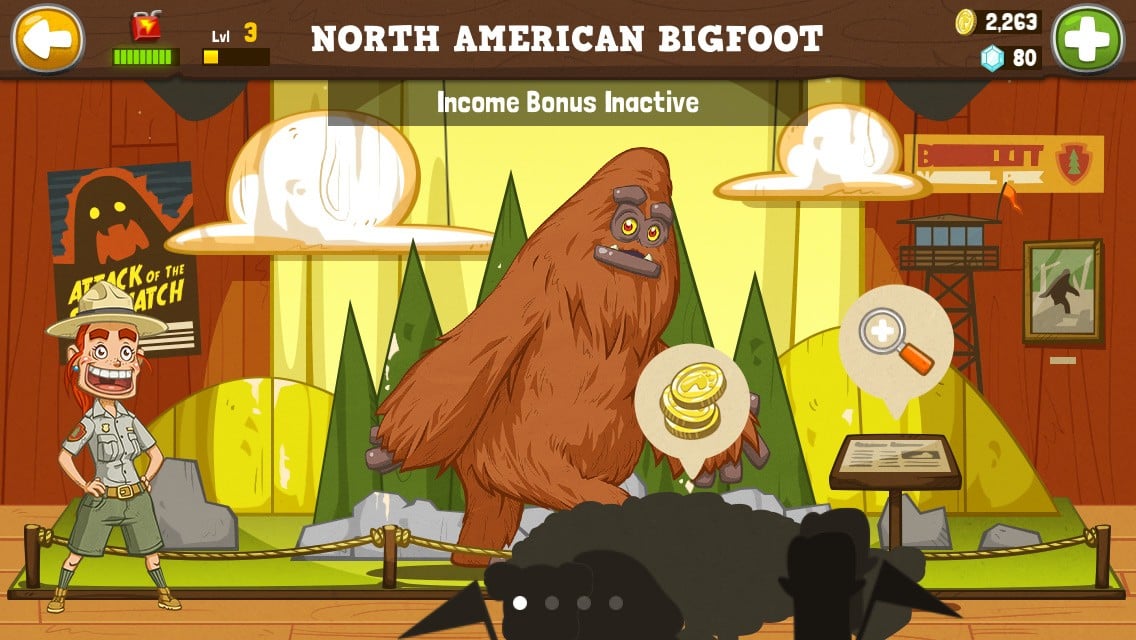
This is one of many aspects that feels poorly implemented and unpolished in the final game. Besides the lazy reskinning of “power,” there are also “missions” that the game uses to award EXP for leveling up, but they’re all the standard events you’ll have to do to move forward. When I was trapped at the $100,000 camera requirement, one of my missions was to buy that camera. Most others are “play the level you’re currently on” or “collect your money from the Bigfoot exhibit.” They’re never interesting challenges like “Photograph ten owls” or “Capture a squirrel and rabbit in the same photo,” or anything remotely related to the photography aspect of the game. The Bigfoot exhibits are, as we mentioned, merely areas to tap to collect small amounts of money. While you can view some past photos here, you can’t design the exhibit yourself or even assign a photo to display. You can choose a pre-determined pose for Bigfoot; that’s about it.
It’s a shame, because the game’s motion controls, graphics, and music are all beautifully done and engaging. But the repetitive gameplay, overwhelmingly grindy economy, and lackluster features greatly detract from what could have been an entertaining alternative to standard murder-box hunting simulations. Bigfoot Hunter is fun for a few levels thanks to its initial spark, but it has little staying power and is actively frustrating once you hit the first paywall. Patient photographers may be able to push through, but the rest of us should let this Sasquatch remain at large.

The good
- Great motion controls that feel like you're actually taking photos with your phone.
- Beautiful and endearing cartoon graphics that bring the animals to life.
- A non-lethal alternative to standard hunting games.

The bad
- Economy is extremely unbalanced and riddled with paywalls; players will have to grind to get anywhere from early on.
- Gameplay quickly becomes repetitive with little difference between cameras, nearly identical stages, and no unique challenges or requirements for the main levels.
- Museum exhibit feels tacked on and like a wasted opportunity for other gameplay features.
More articles...
Monopoly GO! Free Rolls – Links For Free Dice
By Glen Fox
Wondering how to get Monopoly GO! free rolls? Well, you’ve come to the right place. In this guide, we provide you with a bunch of tips and tricks to get some free rolls for the hit new mobile game. We’ll …Best Roblox Horror Games to Play Right Now – Updated Weekly
By Adele Wilson
Our Best Roblox Horror Games guide features the scariest and most creative experiences to play right now on the platform!The BEST Roblox Games of The Week – Games You Need To Play!
By Sho Roberts
Our feature shares our pick for the Best Roblox Games of the week! With our feature, we guarantee you'll find something new to play!All Grades in Type Soul – Each Race Explained
By Adele Wilson
Our All Grades in Type Soul guide lists every grade in the game for all races, including how to increase your grade quickly!







